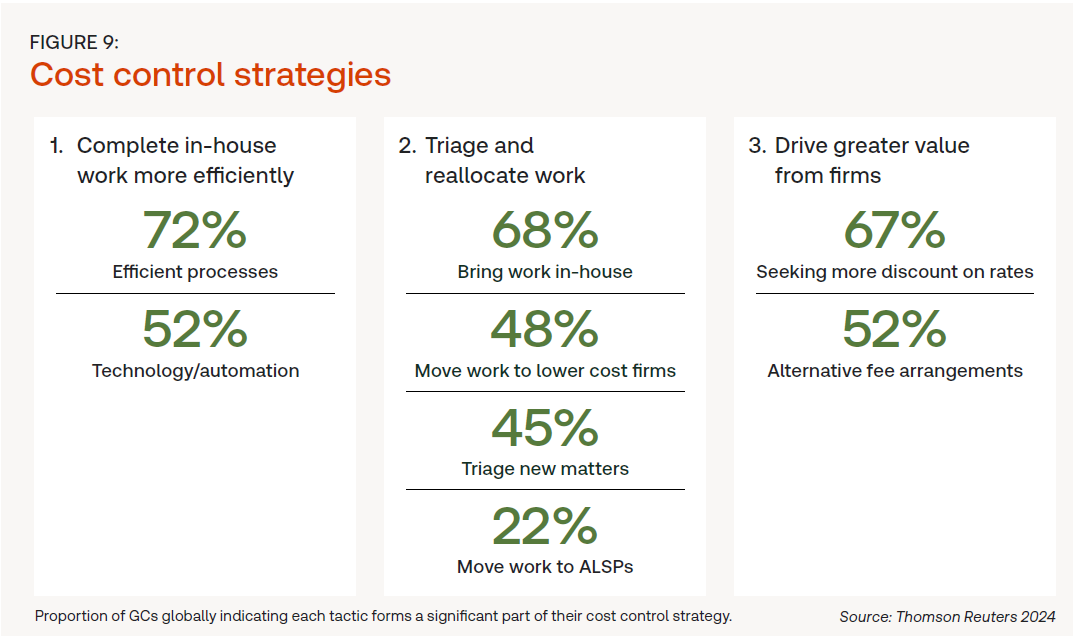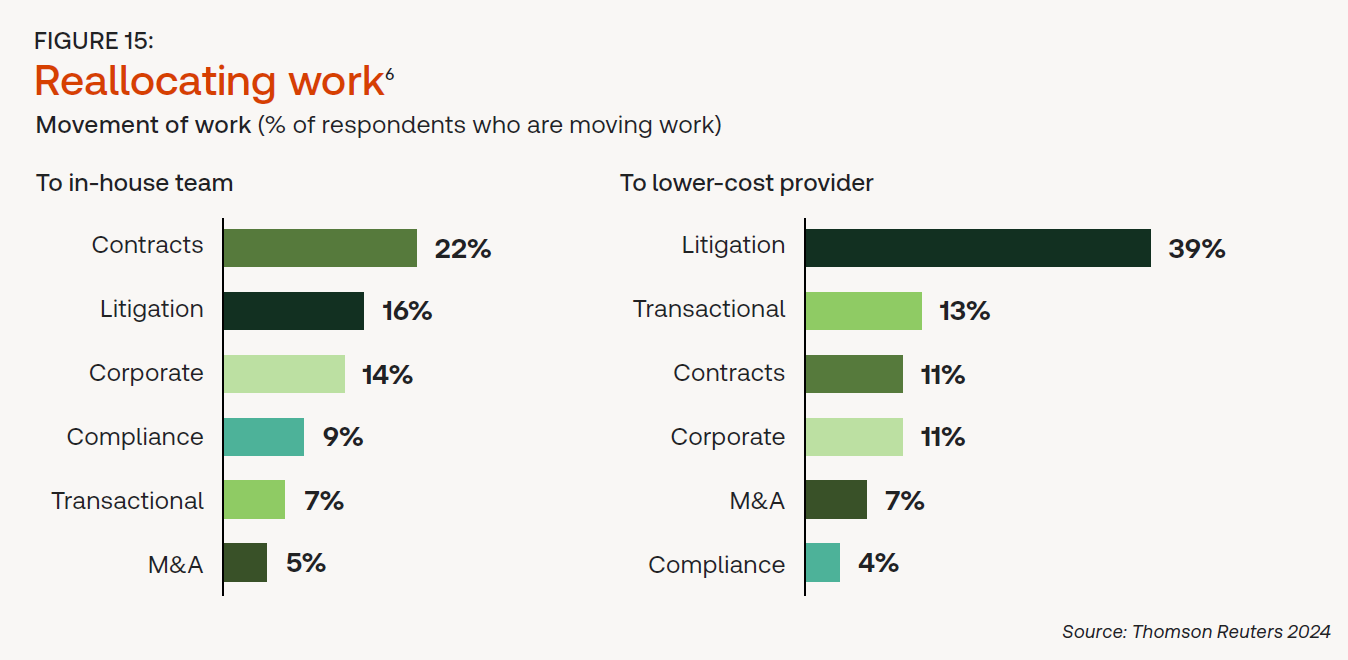General counsel are looking both internally and externally as they seek to optimize their budgets
The need to control costs within a corporate law department is certainly not a new challenge for corporate general counsel (GCs). Indeed, the pressure to do more with less has been prevalent for years and has only increased.
The recently released 2024 State of the Corporate Law Department Report, published in March by the Thomson Reuters Institute, discussed a variety of strategies that GCs have employed in their efforts to better control their departments’ costs.

In fact, both fellow GCs and those outside law firm partners looking to win new client business can learn some valuable lessons from these insights.
Complete in-house work more efficiently
The top priority for GCs seeking to bring more work in-house is to create more efficient internal work processes. Part of the quest for improved processes will undoubtedly involve greater usage of evolving artificial intelligence (AI) technologies. In fact, for 52% of corporate GCs, technology and automation is playing a significant role in their cost recovery strategy, according to the report.
This presents a bit of a conundrum for many GCs. More than 7-in-10 GCs said that AI has the potential to improve department efficiency and that using technology to simplify workflows is a high priority. At the same time, however, 90% of GCs said that their department only makes slow to moderate progress in adopting new technology — and, more worrisome, fewer than one-third are reporting an increase in their legal technology budgets.
The reasonable conclusion, therefore, is that GCs know that AI can help drive better efficiency, moving work in-house and automating work processes wherever possible is going to play a major role in controlling department costs going forward, but GCs still view the uptake of new technology with some skepticism. To overcome this, GCs need to be looking for best practice use cases for technology, either from external exemplars or by notching early wins internally, that can help motivate otherwise reluctant in-house team members to speed up their personal adoption of the available tech stack because of the benefits it will bring, or perhaps more importantly, the pain it can help remove through greater efficiency.
Triage and reallocate work
In addition to looking at how efficiently work is getting done, GCs are also exploring the question of who is doing the work. Roughly two-thirds of GCs said they are bringing more work in-house as part of their cost control efforts, according to the report. Here again, increased efficiency made possible through technology will play a major role in creating capacity for in-house lawyers to more easily absorb increased workloads.
But it’s not simply a question of whether work will be handled in-house or by outside counsel. GCs are also closely scrutinizing which law firms they’re sending their work. Nearly half of GCs said that they plan to send more work to lower-cost legal service providers, whether smaller law firms or alternative legal service providers — and this is not a new trend. In fact, it’s something we’ve been discussing for several years in our annual Report on the State of the US Legal Market, including in the most recent iteration. For the past two years, Midsize law firms in the US — those that exist outside the Am Law 200 rankings — have been the clear winners in terms of increasing demand growth. More recently, clients seem to be shifting in favor of Am Law Second Hundred law firms. Regardless, both law firm segments present rate-friendly alternatives to larger firms, making them appealing candidates for GCs looking to source lower-cost legal services.
GCs are also clear about the types of legal work they’re looking to reallocate.

Contracts work is the most likely task to be brought within the corporate law department; and litigation matters are the most likely legal work to be shifted to lower-cost law firms, with nearly 40% of GCs saying they’re looking for lower-cost litigation counsel. Given the recent results reported in the Q1 2024 Law Firm Financial Index (LFFI) that showed 3.8% growth in litigation demand for the average law firm, that shift could prove quite lucrative for firms on the receiving end.
Drive greater value from firms
The Q1 LFFI also provided new insight into another issue with which cost-conscious GCs must grapple: Ever-increasing law firm billing rates. In the first quarter of 2024, average law firm agreed rates grew by 6.4%, exceeding even the high pace of rate growth set last year. Notably, the fact that these are agreed-upon rates means that, by definition, clients have agreed to these rate increases in the process of engaging new matters. However, that does not mean they’re not seeking alternatives.
Two-thirds of GCs said they are planning to seek greater discounts on rates as a means of controlling costs. On the one hand, rates are rising at a record clip; yet, on the other, clients say they’re seeking higher discounts — and interestingly, both can be true at the same time. A client that received a 10% discount last year could, in theory, get a higher discount this year even as the firm experiences faster rate growth than the year prior, depending on how much the firm stated it was increasing its standard rates this year. This results in a de facto revenue increase to the outside law firm, despite the higher discount.
To illustrate, let’s assume the firm’s standard rate last year was $100. If the client agreed to a rate of $90, that would mean the client was receiving a discount of 10%. For the sake of argument, let’s assume that represents a 5% increase in agreed-upon rates for the firm from the prior year. This year, then, the new agreed rate is $100, and an 11% increase for the firm. If the firm published a standard rate for this year of $120, that would mean the client’s discount increased to 16.7%. So, that means the firm pushes rate growth while the client receives discounts. In a sense, it’s a win-win of a sort. However, given the actual scale of law firm rates, and clients’ desires to lower overall costs, it is, perhaps, a pyrrhic victory for the client.
Which brings us to the final element of cost control — alternative fee arrangements (AFAs). After sitting stagnant for nearly a decade, many observers feel AFAs may be ripe for a new surge. Clients are expressing greater interest, and many law firms have staffed up their pricing capabilities in order to offer more creative — and hopefully just-as-profitable — pricing arrangements that don’t depend on the billable hour. And there is a growing consensus that AFAs, particularly fixed-fee arrangements, are going to become a necessity in an AI-driven future for legal services.
You can find out more about the operations of Corporate Law Departments here.







